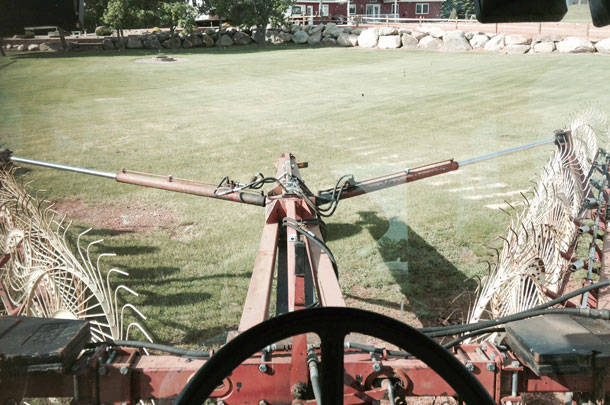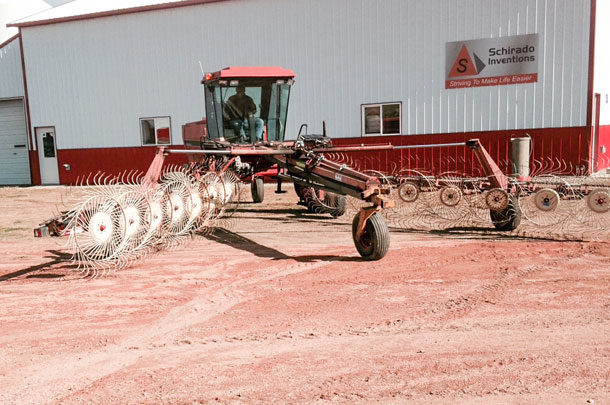“The tractor part of the swather was still good, and I wanted to find another use for it,” Schirado says. “I always kind of thought about putting something else on the front to replace the header.”
With an old V-rake at his fingertips and a lot of old equipment sitting around, he decided to give it a shot.
“I figured it would be kind of a neat project to work on, so I thought it over for a year or two before I started working on it,” Schirado says. “Once I started, I figured I’m not going to stop. I kept pushing at it until I got it to work.”
When Schirado started measuring, he saw right away that he could hook the hay rake up to the swather with almost no alterations. He found the rear axles of the hay rake would fit right where the header attached to the swather. From that point on, Schirado never looked back.
“When I set my mind to something, I just do it,” Schirado says.
Schirado widened the rake so he could pull together windrows made by his 18-foot mower. He accomplished this by extending the main frame and adding an additional rake wheel to each end.
Other than buying the extra wheels, the cost of parts for the self-propelled hay rake was minimal because he borrowed pieces from other old equipment he had lying around.
From an old air seeder tank Schirado mounted a dolly wheel to the rake’s drawbar to hold up the front end where it used to hook onto the tractor. Initially the dolly had dual wheels. However, the two wheels were too heavy and bulky, causing the rake to not pivot as easily, so he switched to a single wheel in the front.
“Anytime you start a project it really never ends up how you first envisioned it,” Schirado says. “You have to keep changing and improving along the way.”

The next challenge Schirado ran into was opening and closing the rake arms. More hydraulic pressure was needed than was available on the swather. To solve the problem, he mounted a hydraulic pump from an old motor to what had been the header driveshaft. He then increased the cooling system to accommodate the heated hydraulic oil.
When he first started using the self-propelled hay rake, the hydraulics would lift too fast and out of control. With the use of chains to secure the rake arms and the addition of tractor weights to the back, Schirado was able to improve stability and not tip into ditches.
Not only was the rake more stable in ditches, but it also proved to be more efficient to run. It helped to lower fuel costs and speed baling and drying time.
“We can get a lot more done with less man power,” Schirado says.
The rake also is more comfortable for Schirado because of the air-conditioned cab and he doesn’t have to turn around to look behind himself. All he has to do is watch the hay coming in the front.
“In this self-propelled rake, you can actually see what you are doing,” Schirado says. “I have way less teeth breaking and bending because I am aware of what I am going over.”
Schirado was able to fine-tune and perfect his self-propelled hay rake to the point where if he were to do it over again, he wouldn’t make any changes to it.
Schirado and his wife, Debbie, run a cow-calf operation and maintain about 5,000 acres of crops and hay. In recent years, he has retired some and cut back two-thirds of his herd. Schirado says he has gone from putting up 2,500 bales a year to around 800 bales and rents out a lot of his land.
Schirado currently operates his own business called Schirado Inventions, where he builds equipment and tools related to feeding and maintaining cattle. Some of the inventions he makes and sells are remote-controlled gates and water hydrants, bottomless bunk bale feeders, net wrap cutters, portable fence and loader gates, and one-handed grease gun systems. These items can be found at the Schirado Inventions website.
“It’s a tough business where not everybody agrees on ideas,” Schirado says. “There are negatives and positives, and it is a roller coaster ride. Sometimes I feel I am biased, but I am open to criticism, and I try to better my inventions by correcting the problem if I get criticism.”
For Schirado, creating new inventions isn’t about making money, but feeling good about utilizing equipment he has sitting around and finding ways he can help people.
“I enjoy the satisfaction of putting something together and seeing that it works,” Schirado says. “I hope to pass a lot of these things on to the public.” ![]()
PHOTO 1: Richard Schirado attached a dolly wheel to the rake's drawbar to hold up the front end.
PHOTO 2: Richard Schirado turned an old swather into a self-propelled rake by mounting his V-rake where the header attached to the swather. Photos provided by Richard Schirado.










